propeller
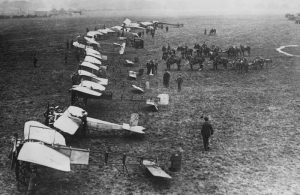 Weapons of warfare have changed over the years, but one of the strangest fighting systems was during World War I, when the planes were not as sophisticated as planes are today. They were slow and at that time, they did not have the guns attached to the planes. Of course they were usually two-seaters, so unlike the World War II planes that had a pilot exclusively assigned to fly the plane, both occupants of the plane had to shoot, or they would be shot down. That was how war was. Kill or be killed.
Weapons of warfare have changed over the years, but one of the strangest fighting systems was during World War I, when the planes were not as sophisticated as planes are today. They were slow and at that time, they did not have the guns attached to the planes. Of course they were usually two-seaters, so unlike the World War II planes that had a pilot exclusively assigned to fly the plane, both occupants of the plane had to shoot, or they would be shot down. That was how war was. Kill or be killed.
The problem of not having guns attached to the plane was really one of control. There was the problem of controlling the plane with shots being fired all around you and no protection in the open cockpit. Then there was controlling the guns in the wind of flight. Not to mention the shots being fired at the open cockpit. The guns the soldiers had on these early planes were carbines and pistols…to take down a war plane…yikes. Of course, there 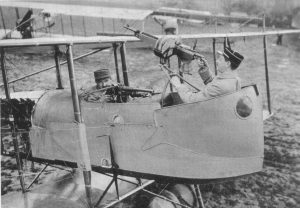 were other problems too. Trying to shoot at the enemy from the cockpit of the plane, the soldier had to be careful not to shoot off the propeller. That would definitely be problematic.
were other problems too. Trying to shoot at the enemy from the cockpit of the plane, the soldier had to be careful not to shoot off the propeller. That would definitely be problematic.
Really, I can’t imagine being a pilot in that war era. You would really be taking your life in your own hands…even more so than the men who flew in later eras, who were also in grave danger, but maybe a little less so. Imagine being the co-pilot in the plane when your pilot is waving his gun around trying to hit the planes flying around you. If the soldier shooting could shoot off the propeller, they could just as easily shoot the other occupant of the plane. I suppose that the pilots fighting in World War I would say that they were just doing their duty, but it seems to me that their “duty” took great courage. Of course, any soldier, no matter what their duty, does their duty, and it always takes great courage. Any soldier 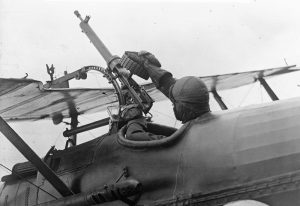 must exhibit great courage in battle. There is no way to go into battle and not be concerned for your safety. And thankfully, as time goes on, weapons of warfare are getting more advanced at being effective, while protecting the soldier in the fight.
must exhibit great courage in battle. There is no way to go into battle and not be concerned for your safety. And thankfully, as time goes on, weapons of warfare are getting more advanced at being effective, while protecting the soldier in the fight.
Of course, those old biplanes had some advantages too. The open cockpit design allowed for easy spying. They could also see the enemy better, and it was easier to drop bombs in those planes, but the later planes made for easier shooting with the attached gun, multiple guns, and the nose guns of the men below the pilots. I’m thankful for the many improvements that have made it easier for our soldiers to come home alive.
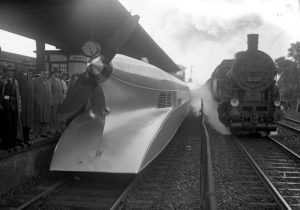 The Schienenzeppelin or rail zeppelin was an experimental railcar which resembled the Zeppelin airship. It was designed by the German aircraft engineer Franz Kruckenberg in 1929. The Schienenzeppelin was powered by a propeller located at the rear. The railcar accelerated to 143 mph setting the land speed record for a petroleum powered rail vehicle. Only one Schienenzeppelin was ever built due to safety concerns. It was never really put into service and was finally dismantled in 1939. The propeller, which powered the railcar, was also the source of concern for its safety. It was exposed, and so the concern was that someone might be hit by he propeller.
The Schienenzeppelin or rail zeppelin was an experimental railcar which resembled the Zeppelin airship. It was designed by the German aircraft engineer Franz Kruckenberg in 1929. The Schienenzeppelin was powered by a propeller located at the rear. The railcar accelerated to 143 mph setting the land speed record for a petroleum powered rail vehicle. Only one Schienenzeppelin was ever built due to safety concerns. It was never really put into service and was finally dismantled in 1939. The propeller, which powered the railcar, was also the source of concern for its safety. It was exposed, and so the concern was that someone might be hit by he propeller.
Anticipating the design of the Schienenzeppelin, the earlier Aerowagon, an experimental Russian high-speed railcar, was also equipped with an aircraft engine and a propeller. On 24 July 1921, a group of delegates to the First Congress of the Profintern, led by Fyodor Sergeyev, took the Aerowagon from Moscow to the Tula collieries to test it. Abakovsky was also on board. Although they successfully arrived in Tula on their maiden run, the return route to Moscow was not successful. The Aerowagon derailed at high speed near Serpukhov, killing six of the 22 people on board. A seventh man later died of his injuries.
The Schienenzeppelin railcar was built at the beginning of 1930 in the Hannover-Leinhausen works of the German Imperial Railway Company. The work was completed by Fall of that year. The vehicle was 84 feet 9 3/4 inches long and had just two axles, with a wheelbase of 64 feet 3 5/8  inches. The height was 9 feet 2 1/4 inches. It had two conjoined BMW IV 6-cylinder petroleum aircraft engines. The driveshaft was raised seven-degrees above the horizontal to give the vehicle some downwards thrust. The body of the Schienenzeppelin was streamlined, having some resemblance to the era’s popular Zeppelin airships, and it was built of aluminum in aircraft style to reduce weight. The railcar could carry up to 40 passengers. Its interior was designed in Bauhaus-style.
inches. The height was 9 feet 2 1/4 inches. It had two conjoined BMW IV 6-cylinder petroleum aircraft engines. The driveshaft was raised seven-degrees above the horizontal to give the vehicle some downwards thrust. The body of the Schienenzeppelin was streamlined, having some resemblance to the era’s popular Zeppelin airships, and it was built of aluminum in aircraft style to reduce weight. The railcar could carry up to 40 passengers. Its interior was designed in Bauhaus-style.
On May 10, 1931, the Schienenzeppelin exceeded a speed of 120 miles per hour for the first time. Afterwards, it toured Germany as an exhibit to the general public throughout Germany. There was still some concern due to the trains speed. On June 21, 1931, it set a new world railway speed record of 143 miles per hour on the Berlin–Hamburg line between Karstädt and Dergenthin, which was not surpassed by any other rail vehicle until 1954. The railcar still holds the land speed record for a petroleum powered rail vehicle. This high speed was attributable, in addition to other things, to its low weight, which was only 44800 pounds.
While several modifications were attempted, ultimately the Schienenzeppelin was scrapped. Due to many problems with the Schienenzeppelin prototype, the Deutsche Reichsbahn-Gesellschaft decided to go their own way in developing a high-speed railcar, leading to the Fliegender Hamburger (Flying Hamburger) in 1933. This new design was much more suitable for regular service and served also as the basis for later railcar developments. However, many of the Kruckenberg ideas were based on the experiments with Schienenzeppelin and high-speed rail travel, found their way into later DRG railcar designs.
The failure, if it could be called that, of Schienenzeppelin has been attributed to everything from the dangers of 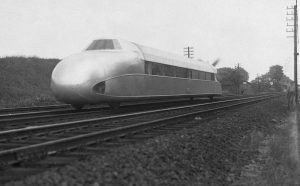 using an open propeller in crowded railway stations to fierce competition between Kruckenberg’s company and the Deutsche Reichsbahn’s separate efforts to build high-speed railcars. Another disadvantage of the rail zeppelin was the inability to pull additional wagons to form a train, because of its construction. Furthermore, the vehicle could not use its propeller to climb steep gradients, as the flow would separate when full power was applied. Thus an additional means of propulsion was needed for such circumstances. Safety concerns have been associated with running high-speed railcars on old track network, with the inadvisability of reversing the vehicle, and with operating a propeller close to passengers.
using an open propeller in crowded railway stations to fierce competition between Kruckenberg’s company and the Deutsche Reichsbahn’s separate efforts to build high-speed railcars. Another disadvantage of the rail zeppelin was the inability to pull additional wagons to form a train, because of its construction. Furthermore, the vehicle could not use its propeller to climb steep gradients, as the flow would separate when full power was applied. Thus an additional means of propulsion was needed for such circumstances. Safety concerns have been associated with running high-speed railcars on old track network, with the inadvisability of reversing the vehicle, and with operating a propeller close to passengers.
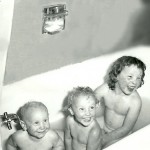 Some babies…and even older kids, absolutely hate to take a bath. I suppose this applies to boys more than girls. Boys don’t seem to have time to take out of their busy day to do something so silly as take a bath. I mean, what is a little dirt anyway. Of course, it might be more fun when there are 2 or 3 in the tub. At least then a guy has friends to play with…making it more like swimming. Still, most of the little boys I have been around would much rather play in a mud puddle than take a bath.
Some babies…and even older kids, absolutely hate to take a bath. I suppose this applies to boys more than girls. Boys don’t seem to have time to take out of their busy day to do something so silly as take a bath. I mean, what is a little dirt anyway. Of course, it might be more fun when there are 2 or 3 in the tub. At least then a guy has friends to play with…making it more like swimming. Still, most of the little boys I have been around would much rather play in a mud puddle than take a bath.
My girls both loved their bath time. They would splash and giggle…as long as you didn’t get soap in their eyes. Washing their hair wasn’t their favorite thing, mostly because of the whole water and soap in their eyes thing, but the rest of the bath was great…especially if there were bath toys to play with. As for me, I loved their bath time. Watching them giggle and play was so cute. Those little baby days go by so fast that a mother has to hang onto the memories, because before you know it, that is all that remains of those baby days.
My girls favorite thing to do as they got a little older was to take bubble baths. It was always so funny to watch them making beards or fancy hairstyles out of the bubbles, or just blowing them off of their hands. It was a great way for little ones to have fun. And it took me back to my own childhood days. When taking a bath meant a good half hour or more of playing in the water. Making boat sounds with my face partly underwater, and 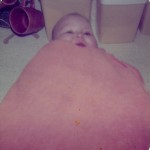 seeing the water churn like a propeller, or seeing how long I could hold my breath were always fun things to do in the bath tub. My mind wandered as I bathed my girls, wishing that these baby years could last forever.
seeing the water churn like a propeller, or seeing how long I could hold my breath were always fun things to do in the bath tub. My mind wandered as I bathed my girls, wishing that these baby years could last forever.
Then coming back to reality, I would lift my clean little daughters out of the water and wrap the snugly in a towel, before putting on their pajamas, the day’s dirt gone, and tucking them in their bed, because one of the nicest things about bath time is that it relaxed the baby and got her ready for bed. After their baths, my girls would just snuggle down and go right to sleep…awwwww, peace!!

